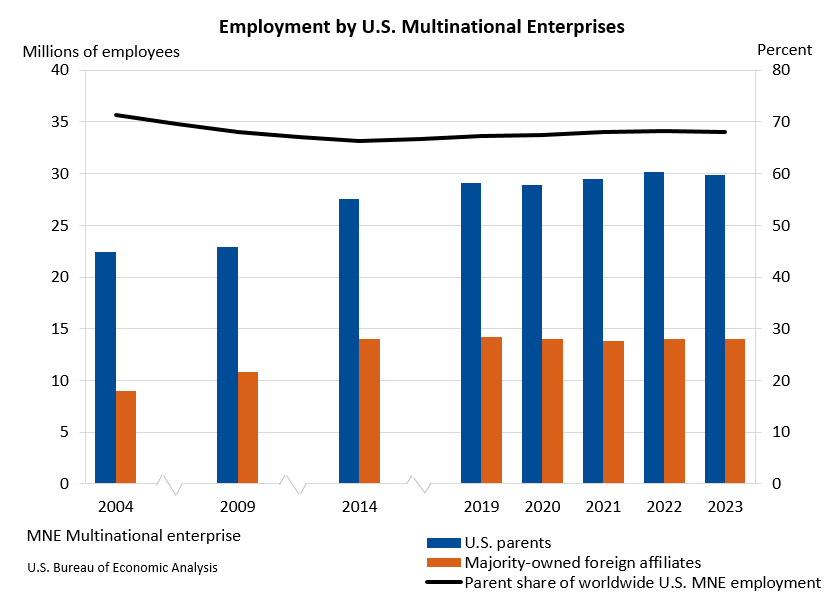Bureau of Economic Analysis
Activities of U.S. Multinational Enterprises, 2023
Worldwide employment by U.S. multinational enterprises decreased 0.4 percent to 43.9 million workers in 2023 (preliminary) from 44.1 million workers in 2022 (revised), according to statistics released today by the U.S. Bureau of Economic Analysis on the operations and finances of U.S. parent companies and their foreign affiliates.
Principal Federal Economic Indicators
Noteworthy
- 2025 News Release Schedule
- Innovation at BEA
- 2025 Annual Updates
- Distribution of Personal Income Nowcast
- New! Services Trade Data for More Countries
- Data Tool: Trade in Value Added
- Updated: RIMS II Regional Multipliers
- Arts and Culture
- Space Economy
- FDI Now in State BEARFACTS
- Quick Guide: Price Indexes
The Latest
Personal Income and Outlays, August 2023
Personal income increased $87.6 billion (0.4 percent at a monthly rate) in August. Disposable personal income (DPI)—personal income less personal current taxes— increased $46.6 billion (0.2 percent). Personal outlays—the sum of personal consumption expenditures (PCE), personal interest payments, and personal current transfer payments—increased $86.0 billion (0.4 percent) and consumer spending increased $83.6 billion (0.4 percent). Personal…
Gross Domestic Product (Third Estimate) and Corporate Profits (Revised Estimate), Second Quarter 2023
Real gross domestic product (GDP) increased at an annual rate of 2.1 percent in the second quarter of 2023, according to the “third” estimate. In the first quarter, real GDP increased 2.2 percent (revised). The increase in the second quarter primarily reflected increases in business investment, consumer spending, and state and local government spending that were partly offset by a decrease in exports. Imports, which are a subtraction in the…
Gross Domestic Product (Third Estimate), Corporate Profits (Revised Estimate), Second Quarter 2023 and Comprehensive Update
Real gross domestic product (GDP) increased at an annual rate of 2.1 percent in the second quarter of 2023, according to the “third” estimate. In the first quarter, real GDP increased 2.2 percent (revised). The increase in the second quarter primarily reflected increases in business investment, consumer spending, and state and local government spending that were partly offset by a decrease in exports. Imports, which are a subtraction in the…
U.S. International Investment Position, 2nd Quarter 2023
The U.S. net international investment position, the difference between U.S. residents’ foreign financial assets and liabilities, was –$18.00 trillion at the end of the second quarter of 2023, according to statistics released today by the U.S. Bureau of Economic Analysis (BEA). Assets totaled $33.58 trillion, and liabilities were $51.58 trillion. At the end of the first quarter, the net investment position was –$16.74 trillion (revised).
U.S. International Investment Position, 2nd Quarter 2023
The U.S. net international investment position, the difference between U.S. residents’ foreign financial assets and liabilities, was -$18.00 trillion at the end of the second quarter of 2023, according to statistics released today by the U.S. Bureau of Economic Analysis (BEA). Assets totaled $33.58 trillion, and liabilities were $51.58 trillion. At the end of the first quarter, the net investment position was -$16.74 trillion (revised).
Experimental Data Map Health Care Estimates in GDP to Centers for Medicare & Medicaid Framework
Today BEA is introducing new experimental data that map our health care estimates in gross domestic product to the framework of CMS’ National Health Expenditures Account, allowing researchers to get an earlier look at 2022 health care spending numbers. The experimental data show health care spending in 2022 rose to more than $4.3 trillion, while the share of GDP declined to 17.1 percent, from a 17.5 percent share in 2021.
U.S. Current-Account Deficit Narrows in 2nd Quarter 2023
The U.S. current-account deficit, which reflects the combined balances on trade in goods and services and income flows between U.S. residents and residents of other countries, narrowed by $2.4 billion, or 1.1 percent, to $212.1 billion in the second quarter of 2023. The narrowing primarily reflected expanded surpluses on services and on primary income that were mostly offset by an expanded deficit on goods. The second-quarter deficit was 3.2…
U.S. International Transactions, 2nd Quarter 2023
The U.S. current-account deficit narrowed by $2.4 billion, or 1.1 percent, to $212.1 billion in the second quarter of 2023, according to statistics released today by the U.S. Bureau of Economic Analysis (BEA). The revised first-quarter deficit was $214.5 billion. The second-quarter deficit was 3.2 percent of current-dollar gross domestic product, up less than 0.1 percent from the first quarter.
Health Care Statistics Updated With Improved Drug Price Data
The Bureau of Economic Analysis today updated its supplemental health care statistics with an improved methodology that shows the growing role of prescription drug rebates over two decades. After subtracting the rebates, BEA's estimate of health care spending in 2020 was reduced by $158 billion, or 5.3 percent, from the previous estimate for 2020.
July 2023 Trade Gap is $65.0 Billion
The U.S. goods and services trade deficit increased from $63.7 billion in June (revised) to $65.0 billion in July, as imports increased more than exports. The goods deficit increased $2.0 billion to $90.0 billion, and the services surplus increased $0.7 billion to $25.0 billion.




